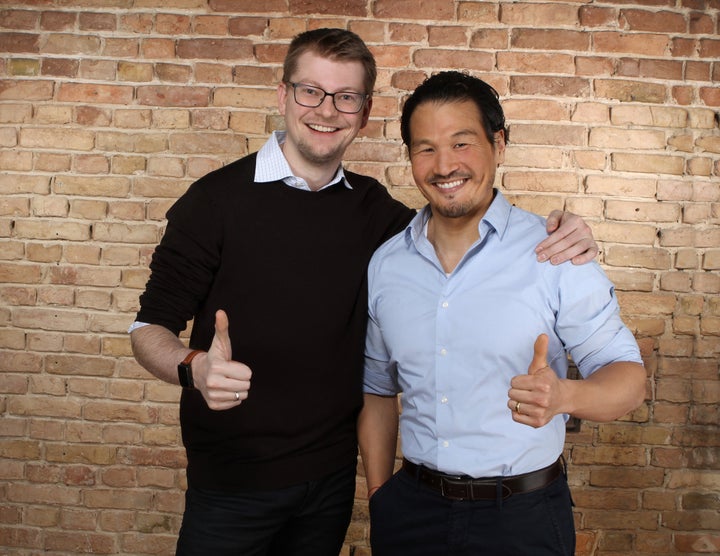
For many years, Richard Lohwasser and Kyung-Hun Ha were highly paid executives at large energy utility companies in Germany.
“I was making really good money,” Ha said. He had regular 9-to-5 hours, and the firm provided him with a big BMW and ample vacation time.
But last year, Lohwasser and Ha quit to found a small startup called Lition Energy. Headquartered in Berlin, the company runs the world’s first marketplace in which customers can choose which renewable electricity plants they want their money to go to.
Lohwasser and Ha were driven by a need to act on climate change and accelerate the deployment of renewable energy. “This summer was one of the hottest summers ever in Europe,” Lohwasser said. “Every one of us needs to do something to contribute, and it’s for sure not the big conglomerate companies that are doing anything about this.”
Both men had grown frustrated at their previous companies. Despite being top-tier executives, they had faced massive resistance to changes they wanted to implement. Even new technologies like smart meters, for example, which can help households become more efficient at using energy, were not adopted by their former companies.

Ha, who ran digital sales for his previous employer, said that sustainability was second only to price when it came to the “emotional hooks” for new electricity customers. In some cases, potential customers accepted higher prices if the energy was renewable. So both Ha and Lohwasser grew disheartened at the “greenwashing” they saw, and sometimes had to carry out, at electricity companies.
“Those companies were proclaiming that they were selling green energy, even though they didn’t,” Ha said.
In Europe and elsewhere (including some parts of the U.S.), as renewable power plants generate electricity, they earn green energy certificates, which they can then sell to non-renewable power plants for additional revenue. Rather than buy electricity from renewable power plants, many large energy companies simply purchase those certificates. “German electricity suppliers usually buy certificates from Scandinavia, where they have 80 percent renewables,” said Esther Marie Mengelkamp of the Karlsruhe Institute of Technology.
The problem is these certificates usually sell for very low prices because supply exceeds demand, making it cheaper for some companies to buy the certificates than to switch to renewables themselves. When companies buy the certificates from foreign, rather than domestic, renewable power plants, that also means the domestic plants are not as profitable as they could be, said Mengelkamp. And most currently operating renewable power plants in Germany were built before the advent of the certificates, said Lohwasser, which suggests that the certificate program has not encouraged the building of new renewable power plants and the transition to a low-carbon society.
“That was the big motivation to found Lition,” Lohwasser said. “To make sure that it’s not the big fat oligarch company that gets the money and fools the customer, but the power plant that makes sure our children have greener futures.”
To do this, Lition Energy cuts out the middlemen through a peer-to-peer, or P2P, marketplace. Customers are directly connected to renewable power plants, such as solar or wind farms, in the company’s marketplace. About 1,000 households in 25 German cities are now connected to seven plants in the marketplace, which is available to the entire country, according to Lition.
Lition Energy is not the only P2P marketplace for energy. One of the earliest pioneers of this idea is the Brooklyn Microgrid project in New York City, launched in 2014 by LO3 Energy. Worldwide, other projects include Australia-based Power Ledger and Singapore’s Electrify Asia.
“That was the big motivation to found Lition. To make sure that it’s not the big fat oligarch company that gets the money and fools the customer, but the power plant that makes sure our children have greener futures.”
- Richard Lohwasser
Blockchain, which is best-known for enabling cryptocurrencies like Bitcoin or Ether, is the technology that supports such P2P marketplaces. It’s an accounting platform where transactions are recorded as blocks of smart contracts ― lines of code that automatically execute themselves. These blocks are stored in a decentralized database, over hundreds and thousands of servers. This provides transparency and accountability.
Lition Energy’s marketplace is based on the blockchain protocol Ethereum. On it, consumers can complete transactions directly with renewable power plants. That doesn’t mean the electricity itself travels from that exact plant to the household; like lightning, electricity seeks out the shortest route on the grid from plants to households. But what Lition Energy’s marketplace does is to ensure that when consumers pay for electricity, their money ends up in the hands of the renewable power plants they choose.
“I believe that it is an important step to actually show people where the money is going,” said Mengelkamp.
Without the big corporate middlemen, consumers can pay less and renewable power plants can get paid more. On average, consumers on Lition Energy’s marketplace pay 20 percent less while renewable power plants earn 30 percent more, according to Lohwasser.
The marketplace also allows consumers to build relationships with the plants that they choose to support. Typically, energy is a low-involvement product, which is partly why the large companies can exploit consumers, Ha said. On Lition Energy’s marketplace, he said, some consumers are actively choosing a different power plant to pay every day.
“They finally get a face, you know? Usually power is such an anonymous thing, it just comes out of the plug,” said Lohwasser.
But blockchain is not without its flaws. For one, most blockchain protocols like Ethereum consume a lot of energy because they require a lot of computation power. Both the energy use and the technology’s security flaws get exacerbated as the volume of transactions balloon. To address these issues, Lohwasser and Ha are currently developing a proprietary blockchain protocol with software giant SAP in the hope of replacing Ethereum.
Beyond establishing a P2P marketplace, blockchain could help the electrical grid in other ways. One big problem is that most grids were designed for large, centralized power plants that send electricity in one direction: outward. In contrast, renewable power plants tend to be small and located anywhere in the grid, which mean they sometimes send electricity inward.
This mismatch in the direction of travel is starting to haunt California, said LO3 Energy CEO Lawrence Orsini. There is so much renewable energy, he explained, that solar and wind farms are getting shut off so that the grid doesn’t become destabilized. “You have to coordinate how you use this grid,” said Orsini.
Blockchain could help tell connected appliances and devices when to turn on, turn off, store energy or generate energy.
“If everyone says, ‘I get a good salary, I have a good job, why should I change,’ nothing will ever change.”
- Richard Lohwasser
For Ha and Lohwasser, leaving secure jobs for uncharted waters was not easy. “It was a big decision,” said Ha, who has two kids and also supports his mother.
But there was no ignoring climate change. This sometimes intangible, seemingly faraway issue got real and urgent for Lohwasser when he also became a father two years ago.
“I met so many deaf ears in my old companies,” said Lohwasser. “They say, ‘I’m a well-paid manager, I get a salary, why should I change?’ But if everyone says, ‘I get a good salary, I have a good job, why should I change,’ nothing will ever change.”
For more content and to be part of the “This New World” community, follow our Facebook page.
HuffPost’s “This New World” series is funded by Partners for a New Economy and the Kendeda Fund. All content is editorially independent, with no influence or input from the foundations. If you have an idea or tip for the editorial series, send an email to thisnewworld@huffpost.com
